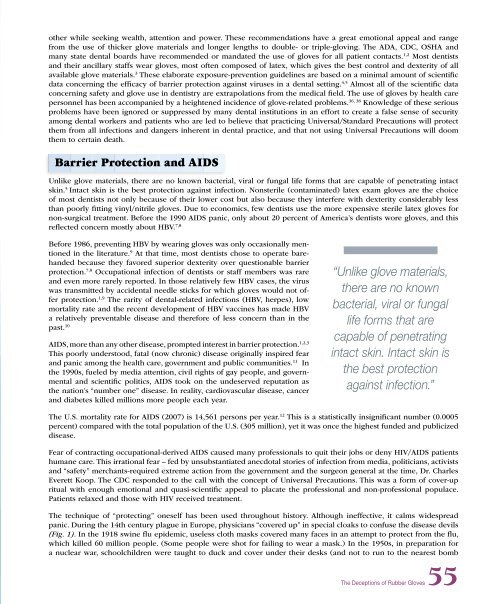PDF Version - Glidewell Dental Labs
PDF Version - Glidewell Dental Labs
PDF Version - Glidewell Dental Labs
You also want an ePaper? Increase the reach of your titles
YUMPU automatically turns print PDFs into web optimized ePapers that Google loves.
other while seeking wealth, attention and power. These recommendations have a great emotional appeal and range<br />
from the use of thicker glove materials and longer lengths to double- or triple-gloving. The ADA, CDC, OSHA and<br />
many state dental boards have recommended or mandated the use of gloves for all patient contacts. 1,2 Most dentists<br />
and their ancillary staffs wear gloves, most often composed of latex, which gives the best control and dexterity of all<br />
available glove materials. 3 These elaborate exposure-prevention guidelines are based on a minimal amount of scientific<br />
data concerning the efficacy of barrier protection against viruses in a dental setting. 4,5 Almost all of the scientific data<br />
concerning safety and glove use in dentistry are extrapolations from the medical field. The use of gloves by health care<br />
personnel has been accompanied by a heightened incidence of glove-related problems. 36, 38 Knowledge of these serious<br />
problems have been ignored or suppressed by many dental institutions in an effort to create a false sense of security<br />
among dental workers and patients who are led to believe that practicing Universal/Standard Precautions will protect<br />
them from all infections and dangers inherent in dental practice, and that not using Universal Precautions will doom<br />
them to certain death.<br />
Barrier Protection and AIDS<br />
Unlike glove materials, there are no known bacterial, viral or fungal life forms that are capable of penetrating intact<br />
skin. 5 Intact skin is the best protection against infection. Nonsterile (contaminated) latex exam gloves are the choice<br />
of most dentists not only because of their lower cost but also because they interfere with dexterity considerably less<br />
than poorly fitting vinyl/nitrile gloves. Due to economics, few dentists use the more expensive sterile latex gloves for<br />
non-surgical treatment. Before the 1990 AIDS panic, only about 20 percent of America’s dentists wore gloves, and this<br />
reflected concern mostly about HBV. 7,8<br />
Before 1986, preventing HBV by wearing gloves was only occasionally mentioned<br />
in the literature. 9 At that time, most dentists chose to operate barehanded<br />
because they favored superior dexterity over questionable barrier<br />
protection. 7,8 Occupational infection of dentists or staff members was rare<br />
and even more rarely reported. In those relatively few HBV cases, the virus<br />
was transmitted by accidental needle sticks for which gloves would not offer<br />
protection. 1,9 The rarity of dental-related infections (HBV, herpes), low<br />
mortality rate and the recent development of HBV vaccines has made HBV<br />
a relatively preventable disease and therefore of less concern than in the<br />
past. 10<br />
AIDS, more than any other disease, prompted interest in barrier protection. 1,2,3<br />
This poorly understood, fatal (now chronic) disease originally inspired fear<br />
and panic among the health care, government and public communities. 11 In<br />
the 1990s, fueled by media attention, civil rights of gay people, and governmental<br />
and scientific politics, AIDS took on the undeserved reputation as<br />
the nation’s “number one” disease. In reality, cardiovascular disease, cancer<br />
and diabetes killed millions more people each year.<br />
“Unlike glove materials,<br />
there are no known<br />
bacterial, viral or fungal<br />
life forms that are<br />
capable of penetrating<br />
intact skin. Intact skin is<br />
the best protection<br />
against infection.”<br />
The U.S. mortality rate for AIDS (2007) is 14,561 persons per year. 12 This is a statistically insignificant number (0.0005<br />
percent) compared with the total population of the U.S. (305 million), yet it was once the highest funded and publicized<br />
disease.<br />
Fear of contracting occupational-derived AIDS caused many professionals to quit their jobs or deny HIV/AIDS patients<br />
humane care. This irrational fear – fed by unsubstantiated anecdotal stories of infection from media, politicians, activists<br />
and “safety” merchants-required extreme action from the government and the surgeon general at the time, Dr. Charles<br />
Everett Koop. The CDC responded to the call with the concept of Universal Precautions. This was a form of cover-up<br />
ritual with enough emotional and quasi-scientific appeal to placate the professional and non-professional populace.<br />
Patients relaxed and those with HIV received treatment.<br />
The technique of “protecting” oneself has been used throughout history. Although ineffective, it calms widespread<br />
panic. During the 14th century plague in Europe, physicians “covered up” in special cloaks to confuse the disease devils<br />
(Fig. 1). In the 1918 swine flu epidemic, useless cloth masks covered many faces in an attempt to protect from the flu,<br />
which killed 60 million people. (Some people were shot for failing to wear a mask.) In the 1950s, in preparation for<br />
a nuclear war, schoolchildren were taught to duck and cover under their desks (and not to run to the nearest bomb<br />
The Deceptions of Rubber Gloves55

















